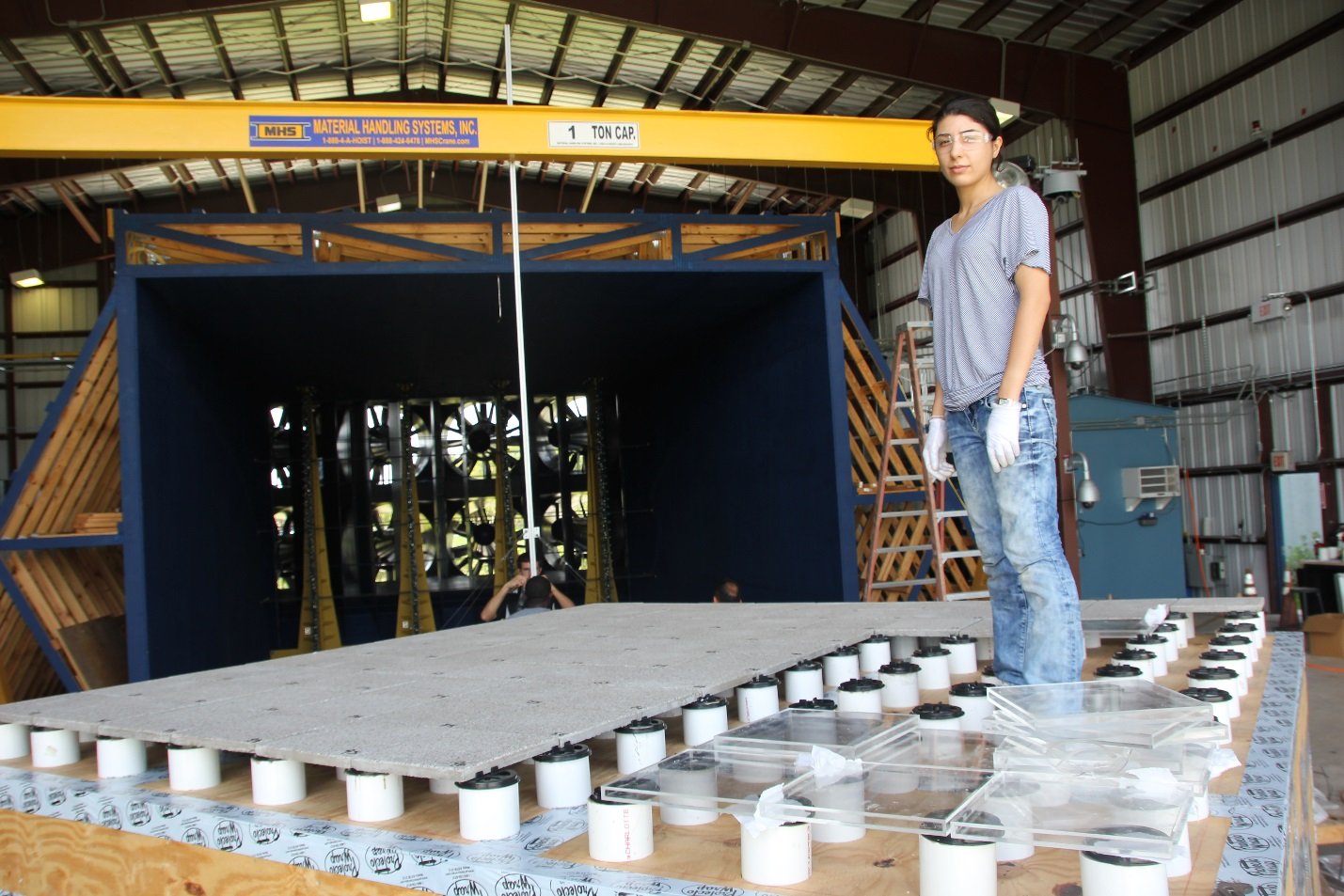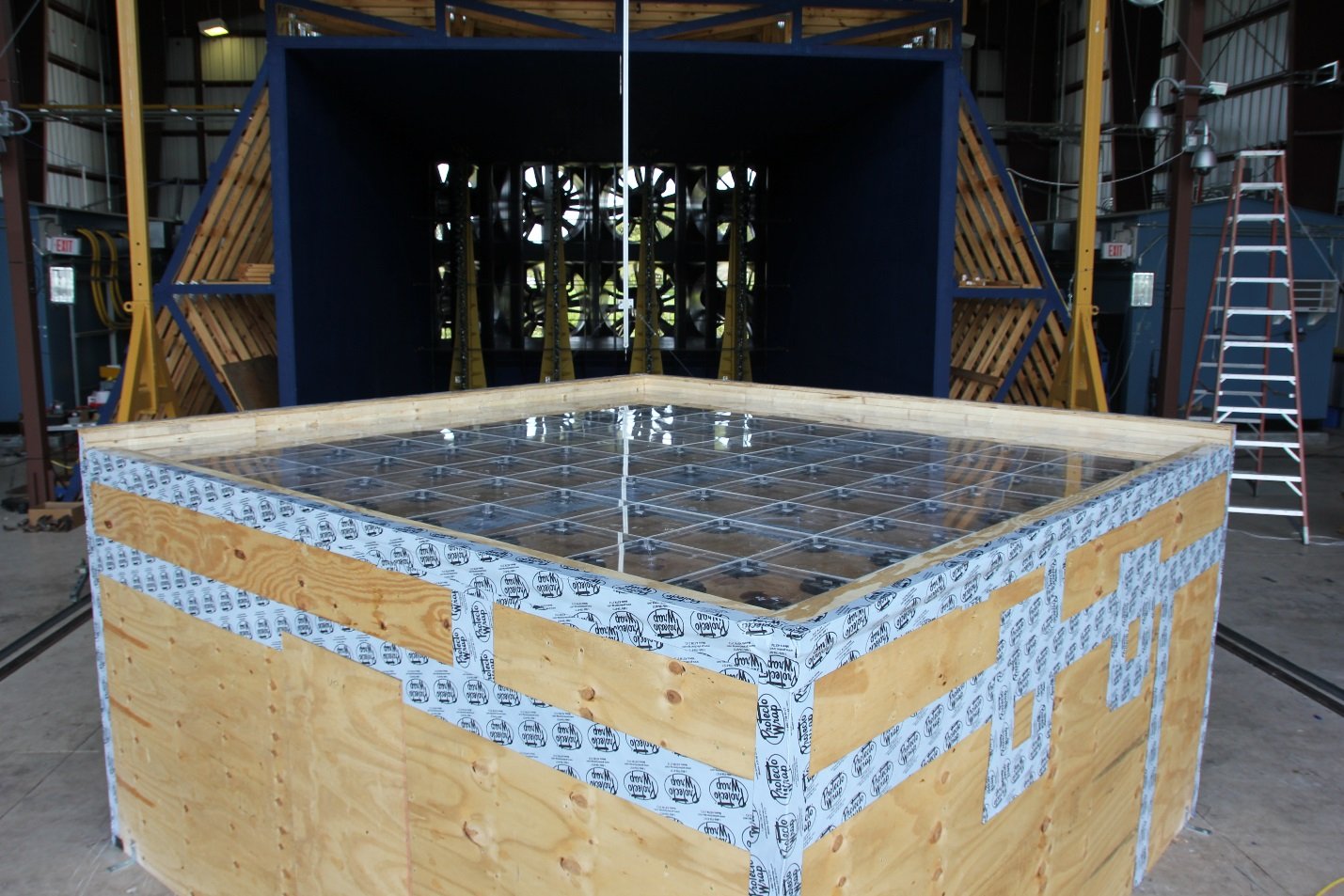Design Guidelines for Roof Pavers Against Wind Uplift
Results from WOW Facility Research Expected to Improve Design Standards
Published on July 31, 2017

Maryam Asghari Mooneghi installing roof pavers for large scale wind testing at the Wall of Wind facility, Florida International University.
In the 1970s and 1980s, Canadian researchers R.J. Kind and R.L. Wardlaw performed pioneering wind-load research on roof pavers. That research provided the foundation for the paver criteria that is in the International Building Code (IBC).
Subsequent experimental and numerical studies for investigating wind loading mechanisms on roof pavers have provided more insights on paver wind loads; however, that research has not been transformed into practice. Although pavers often provide adequate wind resistance, they can blow off roofs and pose safety threats.

Maryam Asghari Mooneghi, PhD, Structural Analyst in Advanced Technology and Research Team, Arup, San Francisco

Tom Smith, AIA, RRC, F.SEI TLSmith Consulting Inc.
To address the problem, Maryam Asghari Mooneghi and her team at Florida International University conducted a series of studies to investigate the wind loading mechanism on air-permeable roofing systems including roof pavers. Investigations took place in 2013-14, as part of Mooneghis PhD research.
The project built upon previous research by conducting largescale experiments that were not possible prior to the existence of the Wall of Wind at FIU. The objective was to develop simple guidance, in code format, for design of loose-laid roof pavers against wind uplift. Roof systems experience the most wind loading compared to any other building component, Mooneghi says.
Major international codes and standards for wind loads in the U.S. and Canada (NBCC; ASCE 7) specify roof wind pressures for typical roof geometries, but there are no specific provisions on how to apply such pressures to roof pavers. We conducted a series of studies to investigate the wind loading mechanism on roof pavers and developed simple design guidelines suitable for inclusion in codes and standards, she says.
Experimental Methods
Mooneghi and her team performed large-scale experiments to investigate the wind loading on concrete roof pavers on the flat roof of a low-rise building in the Wall of Wind facility at FIU.
The Wall of Wind facility at FIU can generate up to a Category 5 hurricane wind speed and is suitable for full-scale and large-scale destructive testing of roofing systems, she explains.
Experiments included wind blow-off tests and pressure measurements on the top and bottom surfaces of pavers. The basic test procedure consisted of first conducting wind blow-off tests. The aim was to provide guidance on the location where paver blow-off, i.e. failure, first occurs, which could then be used to decide on the pressure tap layout for detailed pressure measurements.
Developing Design Guidelines
Based on the experimental results, simplified guidelines were developed for design of loose-laid roof pavers against wind uplift and published in 2016 (Towards guidelines for design of looselaid roof pavers for wind uplift, Wind and Structures, Vol. 22, No. 2, 133-160).
The guidelines are formatted so that designers can make use of the existing information in codes and standards such as ASCE 7-10 standards pressure coefficients for components and cladding. The effects of the pavers edge-gap to spacer height ratio and parapet height to building height ratio are included in the guidelines as adjustment factors.
Shortly after the design guidelines were published, they were put to use by Tom Smith, a roof consultant investigating a case in which pavers blew off a 25-story building. The design criteria developed by Maryam and her team at FIU were vital for developing a solution to the blow-off problem. The reroofing work involved installation of pedestals to optimize the paver gap/spacer height ratio and connecting the pavers with straps to distribute the uplift load to adjacent pavers, Smith says.
The guidelines will be balloted later this year for inclusion in ANSI/SPRI RP-4 (2013), Wind Design Standard for Ballasted Single-ply Roofing Systems, which is referenced in the IBC.
Until the RP-4 changes are made, designers can use the design guidelines referenced above. The specific changes that have been recommended to RP-4 appear in a recent paper published by Mooneghi Arindam, Smith, Peter Irwin, and Gan Chowdhury: Concrete Roof Pavers: Wind Uplift Aerodynamic Mechanisms and Design Guidelines A Proposed Addition to ANSI/SPRI RP- 4, in the Proceedings of the 32nd RCI International Convention and Trade Show, March 2017.
This research was supported by the Florida Division of Emergency Management and the National Science Foundation (Award #1151003) through the 12-fan Wall of Wind flow simulation laboratory at Florida International University.

Test building for pressure measurement experiments.

Plastic pavers instrumented with pressure taps.
NHERI Quarterly
Summer 2017
NHERI Five-Year Science Plan Published
Summer Updates from the NHERI NCO
The Importance of Data Publishing with Ellen Rathje
Project Aims to Revolutionize Design in Wind Engineering
Design Guidelines for Roof Pavers Against Wind Uplift
Hazard Researchers Embracing Biogeotechnics







